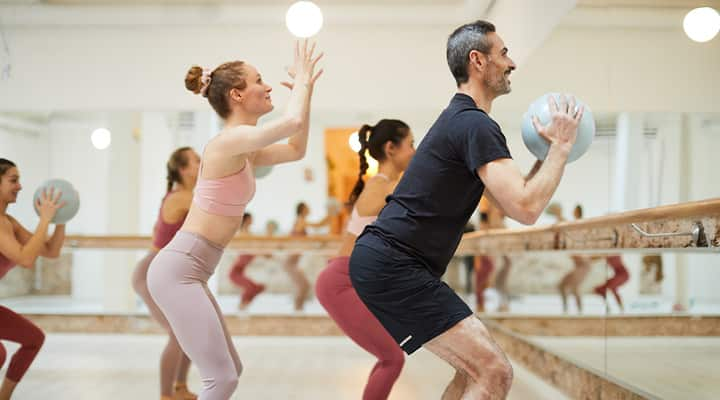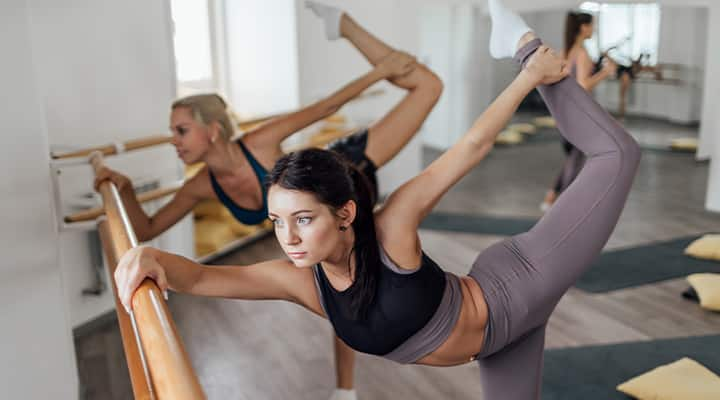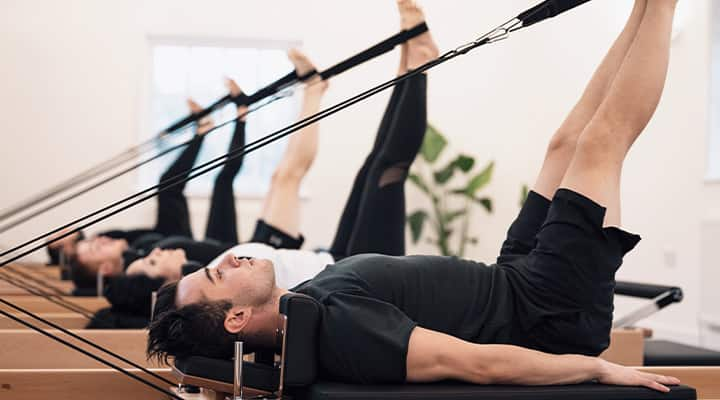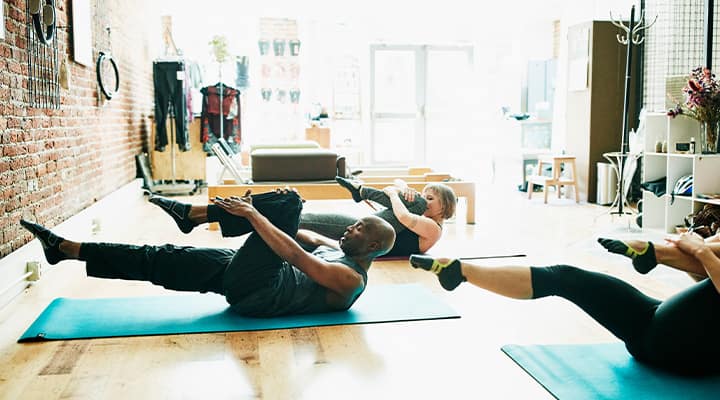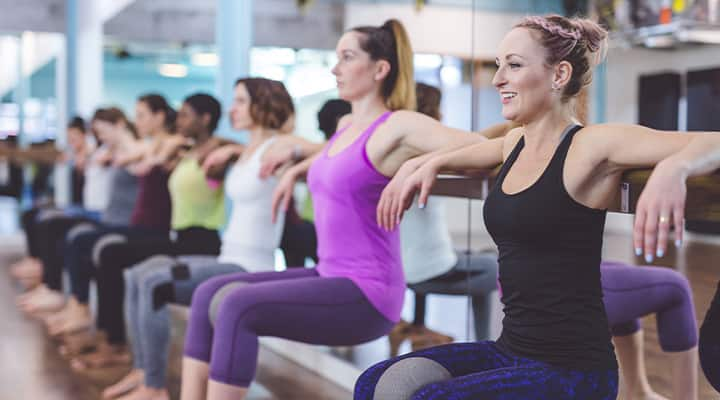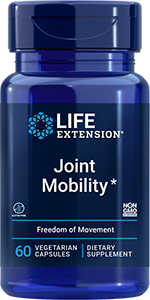
Barre vs. Pilates: What’s the Difference?
Published: November 2024
So, you want more muscle tone in your arms and legs, rock-hard abs and a "lean" look? What you're looking for is a Pilates class. No, wait. Maybe a series of barre workouts would be better. After all, ballet dancers are always in such great shape.
Choosing between barre and Pilates is tough. Both forms of exercise will sculpt your muscles and provide overall body awareness. But they also have some key differences.
Let's take a deeper look at the two workouts, so you can make the best decision for yourself.
What is barre?
Barre exercises are a combination of yoga and ballet moves. In fact, they are named for the ballet barre used in dance studios. Dancers use this horizontal pole for support while they practice various positions and maneuvers.
Contrary to what you might think, you don't need to be a seasoned dancer to take a barre class. These low-impact workouts are designed for all fitness levels. Some might even describe barre workouts as meditation in motion, because the emphasis is on making a mind-muscle connection and syncing your breath with each movement.
What is Pilates?
Pilates was created in the early 1920s by a German gymnast and bodybuilder, Joseph H. Pilates. Pilates originally developed his namesake exercise routine while being held in an internment camp during World War I, sharing it with others in the camp as a means of rehabilitation and strengthening both mind and body.
It was during his detainment that Pilates attached bedsprings to the wall to create resistance for exercises participants were doing in their hospital beds. These makeshift "exercise machines" would later inspire the Pilates Reformer—a sliding platform that provides resistance through springs and a pulley system.
When creating the workout, Pilates pulled from his knowledge and practice of yoga, martial arts and meditation, plus various Greek and Roman exercises.
Like barre, Pilates involves low-impact exercises. These exercises can be adapted to be more or less challenging depending upon the needs of the individual, whether that's offering a new way for an athlete to push their limits, helping someone who needs rehabilitation after a setback, or anything in between.
Barre or Pilates: which is more effective?
It's impossible to say barre is more effective than Pilates, or that Pilates is more effective than barre. Everyone defines effectiveness differently, based on your overarching health and fitness goals. But one place to start your comparison shopping is to consider the benefits of each of these workouts, so you can determine which one best aligns with your specific goals. (Or make room in your schedule for both). Here's the breakdown.
What are the benefits of barre?
Known for promoting both physical and mental balance, barre has a number of benefits:
Building total-body muscle strength—
Barre classes may be low-impact workouts, but they are still designed to challenge different muscle groups. During barre, you move your bodyweight or light resistance through a high volume of repetitions. However, it is the high volume of reps and continuous time under tension that leads to muscle fatigue. Pushing your muscles to the point of fatigue builds muscle strength, especially when you maintain a consistent workout routine.Supporting bone health—
Like muscle mass, bone density naturally declines with age. The good news is any weight-bearing physical activity can help support healthy bones for the long run. Even though you may not use dumbbells or weights for every barre exercise, this type of workout is considered a weight-bearing activity. Simply moving your own body weight unassisted against gravity can benefit your bone health.Improving balance and flexibility—
Many barre exercises are unilateral, meaning you work one side of the body at a time. These types of exercises challenge your balance. Barre also includes a lot of targeted stretches, which help improve range of motion and, therefore, increase flexibility.
Pro tip: Balance and flexibility are not only important for supporting your fitness. You need these physical components to perform everyday activities—from climbing stairs to cleaning the house.
Reducing stress—
Exercise of any kind releases feel-good endorphins. What's unique about barre, though, is that it focuses on syncing your breath with your movement. This can be very therapeutic for your mood and overall well-being.
What are the benefits of Pilates?
Pilates, the ultimate abs shredder, also has a number of well-studied benefits:
Strengthening the core muscles—
One of the most commonly known benefits of Pilates is core strength, and now there's research to back it up. In one study, participants took two one-hour Pilates sessions per week. After 12 weeks, the experimental group showed improvement in abdominal strength and upper spine posture.Balance and stability—
Your ab muscles—rectus abdominus, transverse abdominis and obliques—play a critical role in providing stability. Not only does Pilates focus on core strength, but it works the core muscles from all angles and with varying intensity. This type of training prepares the core to remain strong and stable in diverse scenarios. Imagine yourself walking down the street and someone bumps into you from behind. You don't see them coming, but your strong core instinctively engages and keeps you from tipping over.Improving posture—
Remember that Pilates was originally founded for rehabilitation. The various rehabilitation methods incorporated into Pilates exercises have proven to support a healthy lower back. When you pair healthy lower back muscles with core strength, your body learns how to stay upright and in alignment. In other words, do enough Pilates exercises and you will improve posture.Supporting a healthy immune system—
Can an exercise class really help your immune system? The science says it can. While heart-pumping cardio workouts may have a more pronounced impact on the adaptive immune system, low-impact routines are still extremely beneficial. Pilates exercises, specifically, were shown to influence the proportions of regulatory T cells, which may lead to an enhanced immune system response.
Pilates v. Barre: Which One Gives You the Fastest Results?
The results you achieve from Pilates or barre are completely dependent on the routine you create for yourself. In other words, you get out what you put in. The most important part of any exercise routine is being consistent. Once you've gotten yourself into a workout groove, then you can start to rev up the engine.
Whether you do barre or Pilates, you'll get faster results if you:
- Increase the intensity of your workouts—Increasing the intensity might mean you go from a Pilates mat class to the Pilates Reformer. Or you can easily advance in barre by adding medicine balls or ankle weights to the exercises. Other ways to increase intensity include changing the tempo of the exercises or simply working out more frequently.
- Work out with a friend—The buddy system can be helpful in keeping yourself accountable. Going to the gym with a friend can also bring out a playfully competitive spirit. Watching a friend push hard in class or advancing movements can inspire you to do the same. For this reason, both Pilates and barre studio classes are very popular.
- Focus on recovery—What you do in the time between your workouts is just as important as the workouts themselves. Make sure you're stretching after class and getting adequate rest to recover your muscles.
- Eat nutritious foods—A healthy diet contributes to the recovery process and ensures you're ready to perform your best during your next Pilates or barre class. Choose minimally processed foods as often as possible, so your body gets the best mix of micronutrients and macronutrients for exercise.
Explore Our Best Active Lifestyle & Fitness Supplements
Is Pilates or barre better for strength and endurance?
First, let's understand that muscular strength and muscular endurance are two different things. Muscular endurance is the ability of your muscles to produce force (aka work) over a prolonged period of time. On the other hand, muscular strength is the ability to overcome force from an external source. External sources include dumbbells, resistance bands or even gravity.
You can effectively accomplish strength and endurance with either Pilates or barre. That said, there is evidence that Pilates may be better at improving muscular endurance. Meanwhile, barre workouts have a leg up in building strength.
Better for muscular strength: Barre
Building strength requires pushing muscles to the point of fatigue. This happens by progressively overloading the muscles with increasing rep counts, increasing resistance or changing the tempo.
A barre workout primarily overloads the muscles with high repetitions. So, even though what you're doing is low impact, the sheer volume and intensity of each movement creates that beloved muscle burn.
Best of all, barre doesn't single out any one area. A barre class will strengthen and sculpt all muscle groups. For instance, you'll do overhead extensions for your arms, plié pulses for your glutes and modified arabesque lifts for your core.
Better for muscular endurance: Pilates
Anyone who has taken Pilates knows how tough it can be. You're often challenged to hold stretches or positions, which keeps the muscles engaged for an uncomfortable amount of time. Researchers have actually proven that this type of training builds muscular endurance.
In one randomized controlled study, subjects took a Pilates class consisting of approximately 25 different exercises that focused on core, low back and hips. The results? Taking Pilates classes twice per week for 12 weeks was enough to promote statistically significant increases in abdominal endurance, hamstring flexibility and upper-body muscular endurance.
Which one is best for beginners?
One of the key similarities between Pilates and barre is that they both are safe and suitable for beginners. No matter which type of class you're taking, the instructor will be able to offer modifications to any given exercise.
Or, if you want to increase the intensity of an exercise, the instructor can provide progressions that will give you an extra push. Any instructor worth their weight will want to create a customized barre or Pilates workout that suits all fitness levels and goals.
So, whichever workout you choose, don't be afraid to ask for help and adjust your workout accordingly, up or down—literally!
References
- Balogh L, et al. "The Effect of Aerobic Exercise and Low-Impact Pilates Workout on the Adaptive Immune System." Journal of Clinical Medicine. 2022. https://www.mdpi.com/2077-0383/11/22/6814
- Kloubec J. "Pilates: how does it work and who needs it?" Muscles Ligaments Tendons J. December 2011. https://pmc.ncbi.nlm.nih.gov/articles/PMC3666467/
- Kloubec J. "Pilates for improvement of muscle endurance, flexibility, balance, and posture." J Strength Cond Res. March 2010. https://pubmed.ncbi.nlm.nih.gov/20145572/
Like what you read?
Please subscribe to get email updates on this blog.


